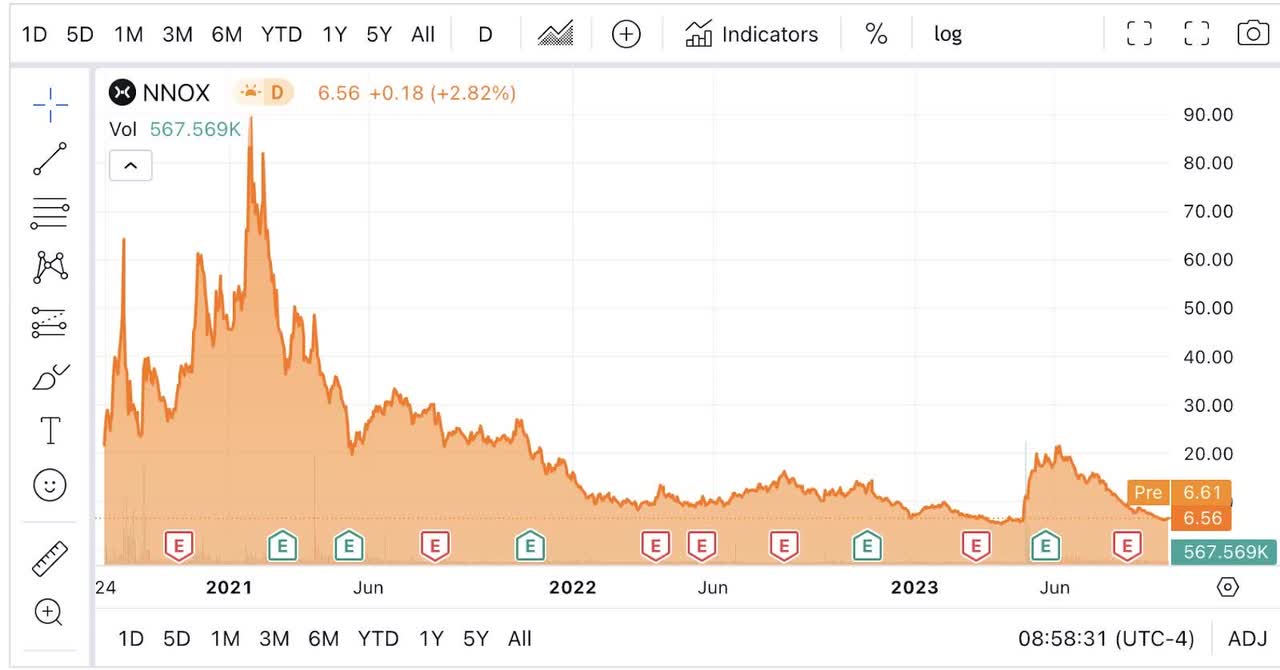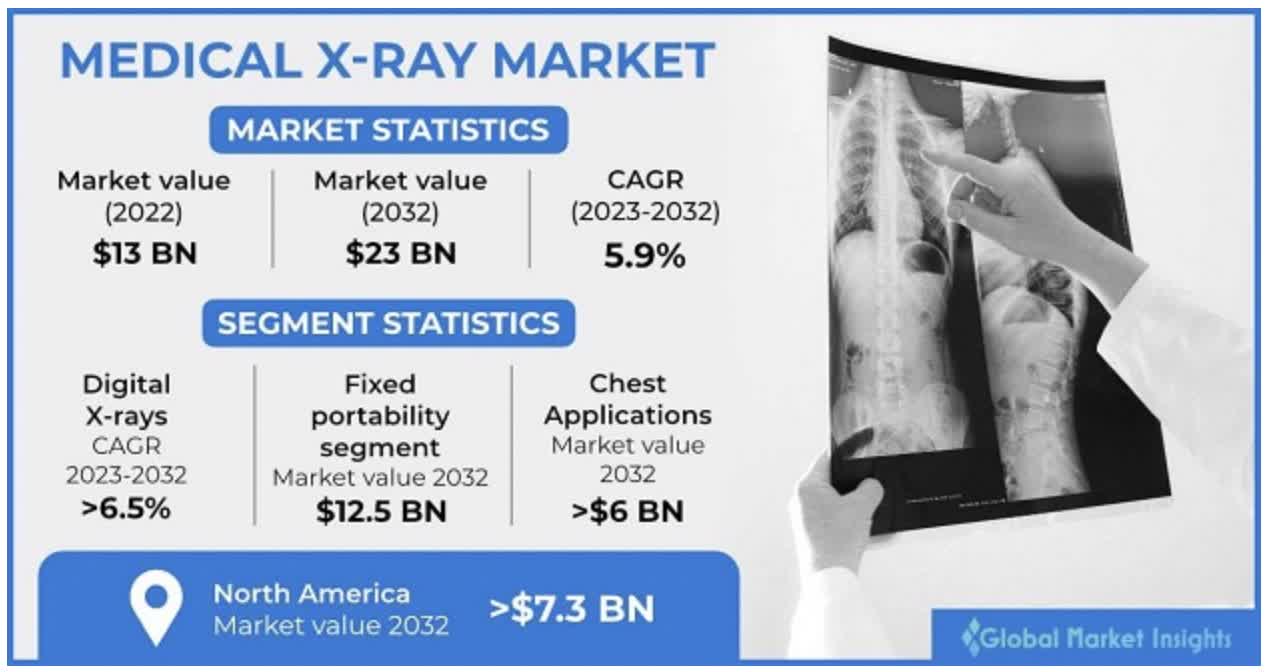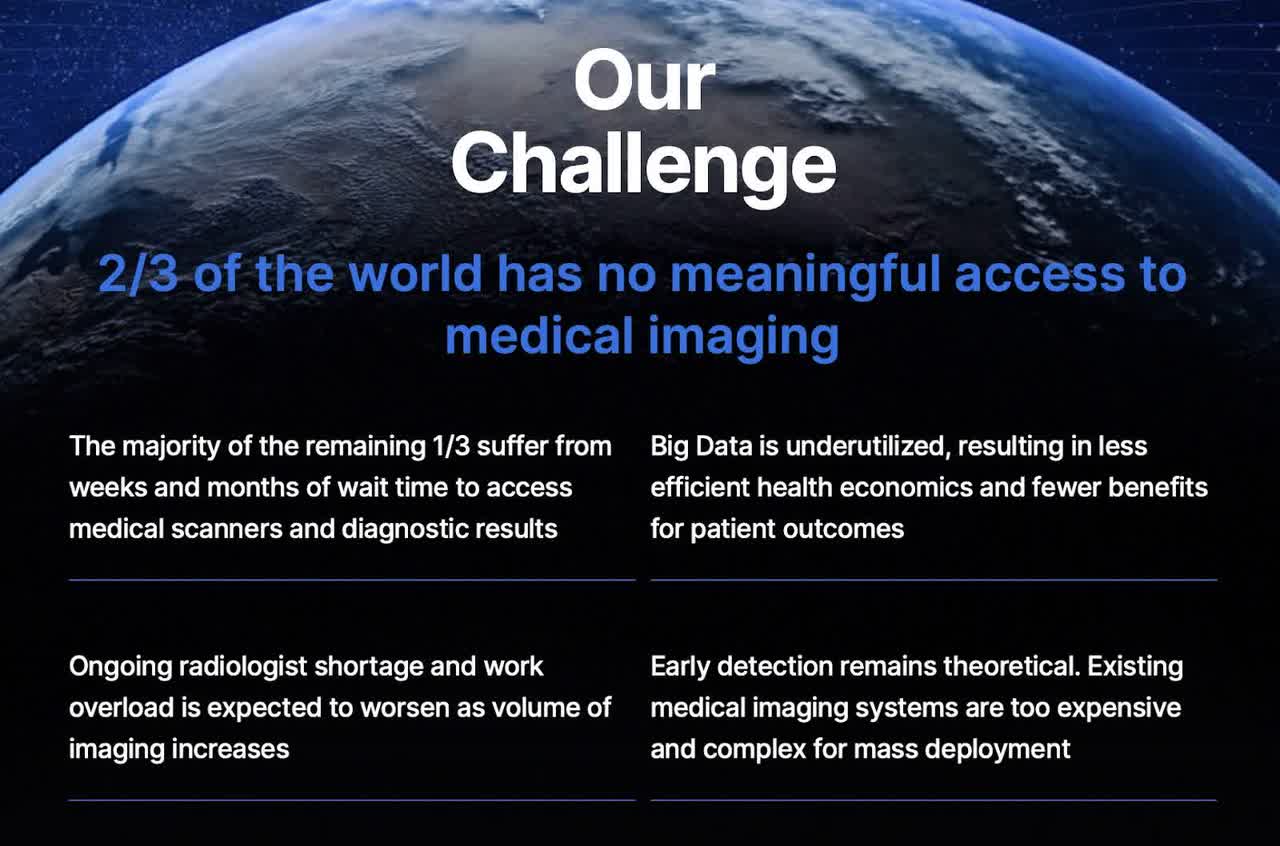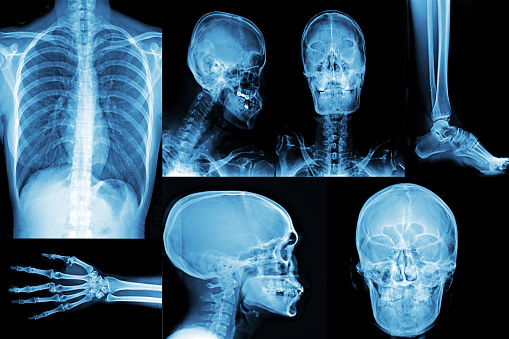Medical Equipment is a large market where disruptive technology that provides lower costs creates competition and progress. Nano-X Imaging Ltd. (NASDAQ:NNOX) is a company at the forefront of tomographic imaging technology, specializing in digital X-ray sources and AI applications for medical imaging. Their innovative solutions include the Nanox Multi Source System, featuring the Nanox.ARC medical tomographic imaging system and Nanox.CLOUD platform for image management and diagnostics. Additionally, Nano-X offers Nanox Marketplace, connecting imaging facilities with radiologists, and AI-based software for detecting medical conditions from existing CT scans. They also provide Teleradiology Services, catering to various healthcare entities. Founded in 2018, Nano-X is headquartered in Neve Ilan, Israel.
Since its IPO at around $24, NNOX rose to an all-time high of almost $90 before the quarterly cash burn and lack of profitability brought its stock price back to reality. As in many cases, the pendulum swung way too high and now has strongly swung back the other way leaving NNOX to trade at a current price of around $6.56. Until NNOX can demonstrate the adoption of its technology on a larger scale, limit its cash burn, and significantly increase revenues, I currently rate NNOX as a hold.
Seeking Alpha
Global Market Insights predicts that the X-ray market will grow from $13 billion in 2022 to over $23 billion by 2032.
Global Market Insights
NNOX wants to be a big part of that growth and believes their low-cost smaller devices will allow more equitable access to X-ray technology globally. They believe their commitment to using Big Data and A.I. will help reduce the impact from a global shortage of radiologists and allow the possibility for improvements in early detection.
They have yet to demonstrate that they will be able to compete in large markets such as the U.S. which already have X-ray technology and equipment.
I believe that NNOX has an advantage in areas without access to current X-ray technology or in areas with a limited number of radiologists. The management seems aware of this issue and is focused on expanding in countries in need of growing capacity for these services.
NNOX Website
CEO Erez Meltzer
-
“Obtaining the 510(k) clearance from the FDA for the multi-source Nanox.ARC has been a long-standing strategic goal for the company…With this clearance, we are now preparing to establish our foothold in the U.S. market”
Achieving FDA clearance is a significant milestone for any medical device company, and it highlights the company’s commitment to its strategic goals in entering the U.S. market. 510(k) clearances are primarily used for medium-risk medical devices which take less scrutiny than high-risk premarket approval devices. I believe this demonstrates that the devices NNOX is producing are considered safe and in line with current X-ray technology.
-
“We believe that this first site will serve a dual purpose: first, as a training and demonstration center for Nanox.ARC, which will provide potential buyers with a live demonstration of the technology…”
The establishment of a clinical site for training and demonstration demonstrates the company’s commitment to educating potential customers and key opinion leaders about the technology, a crucial step in adoption.
-
“Our U.S. go-to-market strategy is comprised of 3 primary components: customer targeting, building the sales team, and using a hybrid business model.”
Outlining the three primary components of the U.S. go-to-market strategy provides clarity on how the company plans to approach the market, emphasizing the importance of customer targeting and sales team development. In regards to the U.S., NNOX is still in the early innings of acceptance. Accomplishing its goals will take substantial costs which is reason to be cautious.
-
“With respect to the rest of the world deployment, turning to our commercialization efforts outside of the U.S. We continue to make significant progress in multiple countries, principally in Africa.”
Expansion efforts in multiple countries, especially in emerging markets like Africa, show the company’s global ambitions and growth potential beyond the U.S. market. These emerging market countries pose a great opportunity for NNOX.
-
“We also regularly host radiologists, distributors, representatives from hospital systems, investors, and analysts at Nanox headquarters in Israel to discuss the Nanox.ARC system in detail…”
Hosting various stakeholders at the company’s headquarters demonstrates transparency and a commitment to showcasing the technology’s capabilities. NNOX continues to try and build traction for its brand.
-
“We have entered an original equipment manufacturing, OEM, relationship with a U.S. government agency that we have signed and are working to develop.”
Collaborating with a U.S. government agency for OEM purposes indicates potential government interest and the versatility of the company’s technology.
-
“We are currently using chips produced by our Korean fabrication facility in our Nanox.ARC system…”
Discussing chip supply sources and manufacturing partners highlights the importance of securing a consistent supply chain for mass production.
-
“We are also in the final stages of approval of additional clinical sites in Israel, and this additional trial aims to utilize the Nanox.ARC in detecting chest and lung diseases.”
Conducting clinical trials to evaluate the diagnostic capabilities of the Nanox.ARC in detecting specific diseases signifies the company’s commitment to validating its technology for medical use.
-
“Nanox.AI is currently engaged in showcasing the product across a range of platforms to 10 integrated delivery networks in both the United States and in other regions.”
The effort to showcase Nanox.AI to integrated delivery networks in multiple regions suggests a proactive approach to expanding the adoption of the company’s AI solutions in healthcare. In many ways I consider this to be the most promising opportunity for growth as AI will allow for many changes in how the technology is applied and will impact its efficacy.
CFO Ran Daniel
-
“We reported a GAAP net loss for the second quarter of 2023 of $17.4 million compared with a net loss of $19.6 million in the second quarter of 2022.”
The company’s ability to reduce its net loss from the previous year is a positive sign, indicating improved financial performance. Deep value investors should monitor if this trend continues and assess the company’s efforts to control expenses and increase revenue. I am following the company’s ability to continue this trend and move towards profitability.
-
“The decrease in the gross profit margin on a GAAP and a non-GAAP basis is mainly due to an increase in the cost of the company’s radiology due to the incentive payments which the company pays to the radiologist to engage in reading during the overnight and weekend shift.”
Understanding the factors affecting gross profit margins is crucial for evaluating the company’s profitability. Although they are currently paying overtime wages to radiologists for reading their scans after hours or during the weekend, the company hopes to use these readings to create a data bank for AI which should reduce future costs.
-
“The decrease of $3.6 million in the general and administrative expenses mainly was due to a decrease in the company’s cost of labor in the amount of $0.5 million due to a reduction in headcount as part of the company’s plan to increase efficiencies.”
Cost-cutting measures and increased efficiency are positive signs for a company’s financial health. The reduction in the headcount is a positive sign, but overall costs remain too high.
-
“During the second quarter of 2023, we had accrued $0.7 million for the future settlement expenses in connection with the SEC investigation.”
Legal expenses and regulatory issues can impact on company’s financials and reputation. Deep value investors should monitor the progress of the SEC investigation and assess the potential financial impact on the company. This is a red flag for potential investors. Trust is a key component of investing and the company will need to act in a more prudent manner in order to regain trust.
-
“On July 26, 2023, we raised $30 million in a registered direct offering by selling approximately 2.1 million shares and warrants to purchase up to 2.1 million shares.”
The successful raising of capital can provide a company with the necessary funds for growth and development. However, these funds will only provide working capital for three quarters. I believe further dilution will be necessary.
Risks
Regulatory Delays and Challenges: The company’s products, especially its Nanox.ARC system, are subject to regulatory approvals in different countries. Delays or difficulties in obtaining necessary clearances can hinder commercialization efforts.
Market Acceptance: Nano-X is introducing innovative technology to the medical imaging industry. Its success depends on the adoption of its products and services by healthcare providers. Resistance to change or skepticism about the efficacy of its technology could impede short-term growth.
Competition: The medical imaging market is competitive, with established players offering conventional solutions. Nano-X needs to demonstrate that its products are not only innovative but also superior in terms of cost-effectiveness and diagnostic accuracy.
Supply Chain Disruptions: Like many other companies, Nano-X may face supply chain disruptions, especially concerning critical components like digital X-ray tubes and semiconductors. These disruptions can impact production and delivery timelines.
Litigation and Legal Issues: The company mentioned an ongoing SEC investigation and potential civil penalties. Legal matters can be costly, distracting, and can negatively affect investor sentiment. You can read more about the $650,000 settlement here.
Financing Needs: Nano-X is a relatively young company with substantial capital requirements for research, development, and commercialization. Depending on external financing, including equity offerings, can dilute existing shareholders and affect stock prices. They recently had a direct stock offering to raise $30 million that you can find here.
Operational Challenges: Scaling up production and commercialization efforts can be challenging, leading to operational hiccups and increased costs.
Global Economic Conditions: Economic downturns or uncertainties can affect healthcare spending and, consequently, Nano-X’s ability to sell its products.
Technological Risks: Developing and deploying cutting-edge technology like digital X-ray sources involves technological risks. Technical glitches, system failures, or performance issues could impact short-term results.
Final Thoughts
NNOX has positioned itself as a potential leader in tomographic imaging technology, offering digital X-ray sources and AI applications for medical imaging. Their innovative product lineup, including the Nanox Multi Source System, Nanox Marketplace, and AI-based software solutions, demonstrates their commitment to revolutionizing the industry. I would like to emphasize that although the company has potential it also has yet to realize that potential.
NNOX’s stock has also experienced significant volatility, soaring to impressive heights before experiencing a downturn. Cash burn of over $40 million annually and profitability concerns sent ANNOX crashing to reality. It is evident that the market sentiment swung from overly optimistic to more cautious. The over-optimism was likely caused by management’s own words. This makes me cautious when listening to management’s current optimism and supports my hold thesis.
The company’s future hinges on demonstrating broader adoption of its technology, reducing cash burn, and substantially increasing revenues. These are difficult benchmarks to reach and I will be following what happens over the next few quarters closely. Given the promising growth projections for the global X-ray market, NNOX aims to play a significant role by providing low-cost, accessible X-ray technology, especially in regions with limited access.
While the company’s commitment to leveraging Big Data and AI to address the shortage of radiologists is commendable, it faces the challenge of competing in established markets like the U.S. where X-ray technology is prevalent. NNOX’s advantage lies in areas without access to current X-ray technology or regions with a scarcity of radiologists. By demonstrating its efficacy NNOX has the potential to break into more saturated markets but this remains to be seen.
NNOX’s go-to-market strategy for the U.S., emphasizing customer targeting and sales team development, provides clarity on how it plans to approach this crucial market. This strategy will incur additional costs and likely mitigate the recent lowering of corporate headcount. Furthermore, the company’s expansion efforts in multiple countries, particularly in emerging markets like Africa, highlight its global ambitions.
Investors should closely monitor its efforts to control expenses and increase revenue. Additionally, the successful raising of $30 million through a registered direct offering provides the company with capital for growth and development. However, this money will only provide operating funds for about three quarters currently and foreshadows the additional need for future fundraising. On a positive note, the company has very little debt and multiple avenues of procuring funds.
Overall, NNOX faces several short-term risks, including regulatory hurdles, market acceptance challenges, competition, supply chain disruptions, legal issues, and the need for financing to support its growth. Addressing these risks effectively will be critical for the company’s short-term success.
Nano-X Imaging Ltd. holds promise as a disruptive force in the medical imaging industry. Still, it must navigate challenges and demonstrate its ability to capture a significant share of the global X-ray market. Investors should carefully assess their progress in reducing losses, expanding market presence, and managing risks before considering an investment. As of now, I rate NNOX as a hold, with future developments warranting close attention. As usual, please do your own due diligence prior to buying any positions, and good luck investing.
Read the full article here













